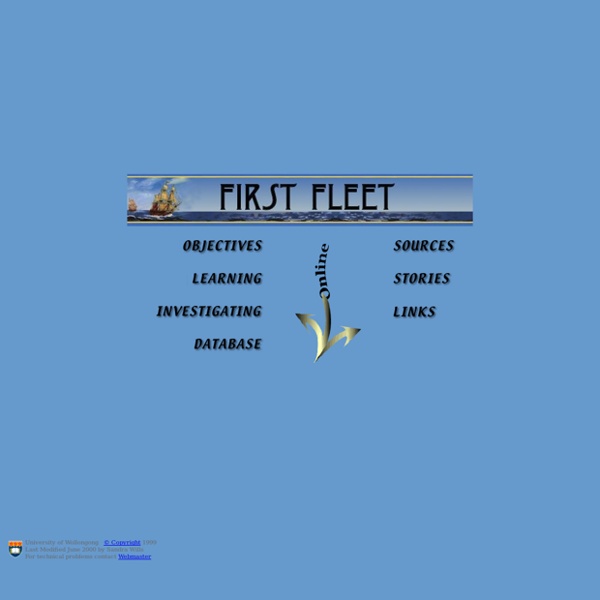



http://firstfleet.uow.edu.au/index.html
Related: Australian History • First FleetEuropean discovery and the colonisation of Australia European mariners Francesco Bartolozzi (1727-1815), Captn. James Cook, F.R.S, 1784, print: stipple engraving. The First Fleet in Sydney Cove, January 27, 1788 [picture] Creator Allcot, John, 1888-1973 Title The First Fleet in Sydney Cove, January 27, 1788 [picture] / John Allcot, 1937
The First Fleet Over 252 days, the First Fleet brought over 1500 men, women and children half way around the world from England to New South Wales. Detail from Botany Bay; Sirius & Convoy going in ... 21 January 1788.from 'A Voyage to New South Wales' by William Bradley, December 1786 - May 1792, Safe 1/14 On 13 of May 1787, the fleet of 11 ships set sail from Portsmouth, England. Led by Captain Arthur Phillip, this historic convoy, which later became known as the First Fleet, carried officers, crew, marines and their families, and convicts from Britain to a distant and little known land on the far side of the world. The Fleet consisted of two Royal Navy escort ships, HMS Sirius and HMS Supply. They accompanied six convict transports, the Alexander, Charlotte, Friendship, Lady Penrhyn, Prince of Wales and the Scarborough, and three store ships, the Borrowdale, Fishburn and Golden Grove.
Encounter 2020 commemorating Cook’s arrival to Australia on Endeavour Captain James Cook’s Endeavour and the impact its arrival had on Australia’s Indigenous peoples will be the focus of a new national travelling exhibition unveiled today. Minister for Communications and the Arts Paul Fletcher and the Minister for Indigenous Australians Ken Wyatt launched the project, called Encounter 2020. Through a series of exhibitions and events around the country, Encounter 2020 will commemorate the 250th anniversary since Captain Cook arrived in Botany Bay and went on to chart the east coast of Australia.
1808 Rum Rebellion On 26th January 1808, officers and men of the New South Wales Corps marched to Government House in Sydney in an act of rebellion against Governor William Bligh. Bligh was arrested and the colony was placed under military rule. This was the only time in Australian history that a government was overthrown by a military coup. The military stayed in power for two years until Lachlan Macquarie, the fifth Governor of NSW, assumed office at the beginning of 1810. The overthrow of Bligh much later became known as the ‘Rum Rebellion’ because the NSW Corps was heavily involved in the trade in rum in the colony and was nicknamed the ‘Rum Corps’. The term 'Rum Rebellion' was not used at the time.
Female Convicts - Convict Stories My dearest Margaret This letter is written to you by my son, Samuel, who can read and write, whereas I never learned to do so. Samuel urged me to tell my story, so that future generations know from whence they came. I was born in Galway, Ireland on 1 August 1811, and was a nursemaid/needlewoman. You would probably think me to be quite a brave young girl when I tell you what happened next. Classroom learning What's new Indigenous cultures and contact history Encounters includes an interactive map, digital timeline and online activities. It is based on the powerful stories shared by Aboriginal and Torres Strait Islander peoples in the Encounters exhibition. (Years 4–10). Can You Strike It Rich During The Gold Rush?
Female convicts The London convict maid, a cautionary tale of life in the colony. Female convicts were predominantly young, single women who had been domestic servants and/or who had come from a semi-skilled background - such as an apprenticeship. The majority of female convicts were first time offenders sentenced to transportation for minor theft (Oxley, Deborah, Convict maids 1996 , pp. 42-48). The Official Globe Trekker WebsiteThe Official Globe Trekker Website Short History of Convict Australia is the first ever documentary about Australia’s convict past. It visits the locations where convicts lived and worked, talks to historians and descendants of convicts and experiences the legacy of the dramatic, brutal birth of a nation. This site is the number one resource for those who want to know more about Convict Australia, and the locations where Australian history actually happened. Containing facts, figures, and relevant footage from the documentary, it’s an educational experience. Who Were the Convicts? The late 18th century was a period of immense social and political change.